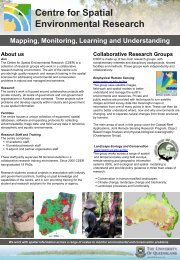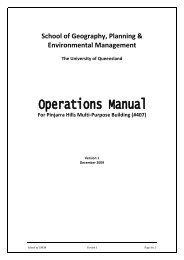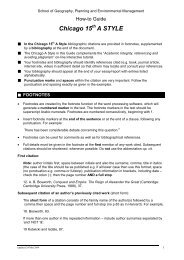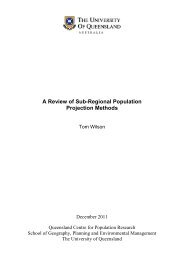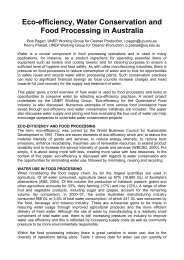Conserving Biodiversity in Brigalow Regrowth - School of ...
Conserving Biodiversity in Brigalow Regrowth - School of ...
Conserving Biodiversity in Brigalow Regrowth - School of ...
You also want an ePaper? Increase the reach of your titles
YUMPU automatically turns print PDFs into web optimized ePapers that Google loves.
CONSERVING BIODIVERSITY IN BRIGALOW LANDSCAPES<br />
roadside vegetation and tree-l<strong>in</strong>es:<br />
are they too narrow?<br />
Narrow l<strong>in</strong>ear strips <strong>of</strong> brigalow remnant woodland are a common feature <strong>in</strong> brigalow landscapes. Long narrow bands<br />
<strong>of</strong> woodland can extend for kilometres along the edges <strong>of</strong> roads, and shade-l<strong>in</strong>es mark the boundaries between<br />
paddocks, provid<strong>in</strong>g shade for stock and protect<strong>in</strong>g crops from w<strong>in</strong>d damage and heat stress.<br />
These narrow strips <strong>of</strong> vegetation are <strong>of</strong>ten thought to be<br />
unimportant for wildlife and <strong>of</strong>ten do not appear on maps <strong>of</strong><br />
protected remnant woodland because they are too narrow.<br />
However, our research has shown that these patches <strong>of</strong><br />
brigalow are <strong>of</strong> great importance to wildlife, support<strong>in</strong>g a<br />
wide variety <strong>of</strong> birds and reptiles.<br />
Many have a high abundance <strong>of</strong> mistletoe plants that<br />
provide important fruit and nectar food sources for<br />
woodland birds, like the rare pa<strong>in</strong>ted honeyeater. These<br />
woodlands also provide corridors for animals to move<br />
among patches <strong>of</strong> woodland.<br />
While wider patches generally provide better habitat<br />
for wildlife, even the very narrowest <strong>of</strong> patches are still<br />
important habitat. Very narrow (< 50 m wide) strips are<br />
particularly vulnerable to further degradation from spraydrift<br />
from adjacent cropp<strong>in</strong>g areas and over brows<strong>in</strong>g and<br />
trampl<strong>in</strong>g by cattle and sheep, as well as w<strong>in</strong>d and storm<br />
damage.<br />
The more heavily grazed <strong>of</strong> these narrow strips have few<br />
young trees regenerat<strong>in</strong>g <strong>in</strong> the understorey to replace<br />
mature trees as they die. The future <strong>of</strong> these woodlands is<br />
uncerta<strong>in</strong>, but there are ways to protect them from further<br />
damage.<br />
Exclud<strong>in</strong>g stock, or reduc<strong>in</strong>g the frequency <strong>of</strong> stock access,<br />
will help to ensure that younger trees can grow to maturity.<br />
Careful use <strong>of</strong> herbicides and reta<strong>in</strong><strong>in</strong>g regrowth woodland<br />
on the edges <strong>of</strong> these patches are all ways to buffer these<br />
important habitat features aga<strong>in</strong>st further damage.<br />
MICHIALA BOWEN<br />
17






